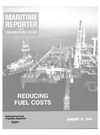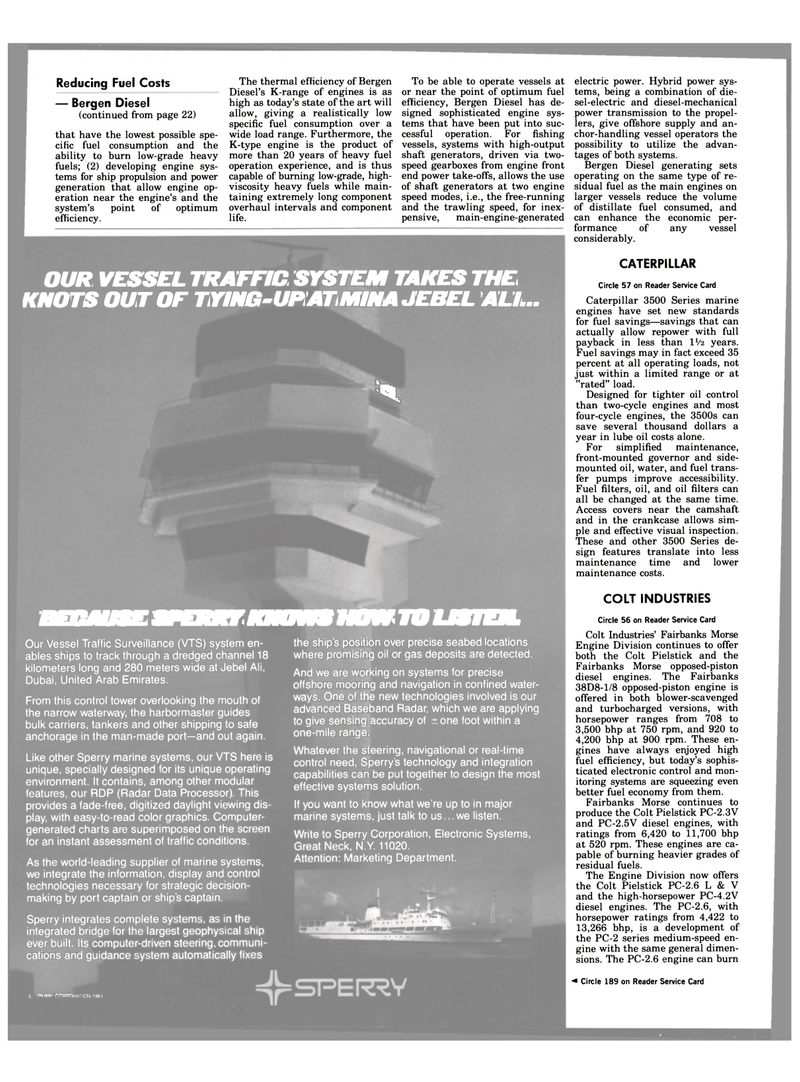
Page 26: of Maritime Reporter Magazine (January 15, 1984)
Read this page in Pdf, Flash or Html5 edition of January 15, 1984 Maritime Reporter Magazine
Reducing Fuel Costs — Bergen Diesel (continued from page 22) that have the lowest possible spe- cific fuel consumption and the ability to burn low-grade heavy fuels; (2) developing engine sys- tems for ship propulsion and power generation that allow engine op- eration near the engine's and the system's point of optimum efficiency.
The thermal efficiency of Bergen
Diesel's K-range of engines is as high as today's state of the art will allow, giving a realistically low specific fuel consumption over a wide load range. Furthermore, the
K-type engine is the product of more than 20 years of heavy fuel operation experience, and is thus capable of burning low-grade, high- viscosity heavy fuels while main- taining extremely long component overhaul intervals and component life.
To be able to operate vessels at or near the point of optimum fuel efficiency, Bergen Diesel has de- signed sophisticated engine sys- tems that have been put into suc- cessful operation. For fishing vessels, systems with high-output shaft generators, driven via two- speed gearboxes from engine front end power take-offs, allows the use of shaft generators at two engine speed modes, i.e., the free-running and the trawling speed, for inex- pensive, main-engine-generated electric power. Hybrid power sys- tems, being a combination of die- sel-electric and diesel-mechanical power transmission to the propel- lers, give offshore supply and an- chor-handling vessel operators the possibility to utilize the advan- tages of both systems.
Bergen Diesel generating sets operating on the same type of re- sidual fuel as the main engines on larger vessels reduce the volume of distillate fuel consumed, and can enhance the economic per- formance of any vessel considerably.
CATERPILLAR
Circle 57 on Reader Service Card
Caterpillar 3500 Series marine engines have set new standards for fuel savings—savings that can actually allow repower with full payback in less than IV2 years.
Fuel savings may in fact exceed 35 percent at all operating loads, not just within a limited range or at "rated" load.
Designed for tighter oil control than two-cycle engines and most four-cycle engines, the 3500s can save several thousand dollars a year in lube oil costs alone.
For simplified maintenance, front-mounted governor and side- mounted oil, water, and fuel trans- fer pumps improve accessibility.
Fuel filters, oil, and oil filters can all be changed at the same time.
Access covers near the camshaft and in the crankcase allows sim- ple and effective visual inspection.
These and other 3500 Series de- sign features translate into less maintenance time and lower maintenance costs.
COLT INDUSTRIES
Circle 56 on Reader Service Card
Colt Industries' Fairbanks Morse
Engine Division continues to offer both the Colt Pielstick and the
Fairbanks Morse opposed-piston diesel engines. The Fairbanks 38D8-1/8 opposed-piston engine is offered in both blower-scavenged and turbocharged versions, with horsepower ranges from 708 to 3,500 bhp at 750 rpm, and 920 to 4,200 bhp at 900 rpm. These en- gines have always enjoyed high fuel efficiency, but today's sophis- ticated electronic control and mon- itoring systems are squeezing even better fuel economy from them.
Fairbanks Morse continues to produce the Colt Pielstick PC-2.3V and PC-2.5V diesel engines, with ratings from 6,420 to 11,700 bhp at 520 rpm. These engines are ca- pable of burning heavier grades of residual fuels.
The Engine Division now offers the Colt Pielstick PC-2.6 L & V and the high-horsepower PC-4.2V diesel engines. The PC-2.6, with horsepower ratings from 4,422 to 13,266 bhp, is a development of the PC-2 series medium-speed en- gine with the same general dimen- sions. The PC-2.6 engine can burn •* Circle 189 on Reader Service Card
OUR VESSEL TRAFFIC SYSTEM TAKES THE
KNOTS OUT OF TYIMG-UP AT MIMA JEBEL ALI... %
BECAUSE SPERRY KNOWS HOW TO LISTEN.
Our Vessel Traffic Surveillance (VTS) system en- ables ships to track through a dredged channel 18 kilometers long and 280 meters wide at Jebel AN,
Dubai, United Arab Emirates.
From this control tower overlooking the mouth of the narrow waterway, the harbormaster guides bulk carriers, tankers and other shipping to safe anchorage in the man-made port—and out again.
Like other Sperry marine systems, our VTS here is unique, specially designed for its unique operating environment. It contains, among other modular features, our RDP (Radar Data Processor). This provides a fade-free, digitized daylight viewing dis- play, with easy-to-read color graphics. Computer- generated charts are superimposed on the screen for an instant assessment of traffic conditions.
As the world-leading supplier of marine systems, we integrate the information, display and control technologies necessary for strategic decision- making by port captain or ship's captain.
Sperry integrates complete systems, as in the integrated bridge for the largest geophysical ship ever built. Its computer-driven steering, communi- cations and guidance system automatically fixes the ship's position over precise seabed locations where promising oil or gas deposits are detected.
And we are working on systems for precise offshore mooring and navigation in confined water- ways. One of the new technologies involved is our advanced Baseband Radar, which we are applying to give sensing accuracy of ±one foot within a one-mile range.
Whatever the steering, navigational or real-time control need, Sperry's technology and integration capabilities can be put together to design the most effective systems solution.
If you want to know what we're up to in major marine systems, just talk to us... we listen.
Write to Sperry Corporation, Electronic Systems,
Great Neck, N.Y. 11020.
Attention: Marketing Department. c SPFRRV CORPOMA! (ON 1983

 25
25

 27
27
